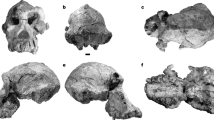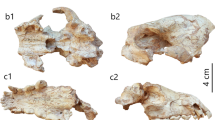Abstract
Fossil apes are known from several late Miocene localities in Yunnan Province, southwestern China, principally from Shihuiba (Lufeng) and the Yuanmou Basin, and represent three species of Lufengpithecus. They mostly comprise large samples of isolated teeth, but there are also several partial or complete adult crania from Shihuiba and a single juvenile cranium from Yuanmou. Here we describe a new, relatively complete and largely undistorted juvenile cranium from the terminal Miocene locality of Shuitangba, also in Yunnan. It is only the second ape juvenile cranium recovered from the Miocene of Eurasia and it is provisionally assigned to the species present at Shihuiba, Lufengpithecus lufengensis. Lufengpithecus has most often been linked to the extant orangutan, Pongo pygmaeus, but recent studies of the crania from Shihuiba and Yuanmou have demonstrated that this is unlikely. The new cranium reinforces the view that Lufengpithecus represents a distinct, late surviving lineage of large apes in the late Miocene of East Asia that does not appear to be closely affiliated with any extant ape lineage. It substantially increases knowledge of cranial morphology in Lufengpithecus and demonstrates that species of this genus represent a morphologically diverse radiation of apes, which is consistent with the dynamic tectonic and biotic milieu of southwestern China in the late Miocene.
Article PDF
Similar content being viewed by others
Avoid common mistakes on your manuscript.
References
Woo J K. Dryopithecus teeth from Keiyuan, Yunnan Province. Vert Palasiat, 1957, 1: 25–32
Zhang X Y. New materials of Ramapithecus from Kaiyuan, Yunnan (in Chinese). Acta Anthrop Sin, 1987, 6: 81–86
Qiu Z X, Qiu Z D. Chronological sequence and subdivision of Chinese Neogene mammalian faunas. Palaeogeogr Palaeoclimatol Palaeoecol, 1995, 116: 41–70
Zhang X Y, Lin Y P, Jiang C, et al. A new species of Ramapithecus from Yuanmou, Yunnan (in Chinese). J. Yunnan Univ (Soc Sci), 1987, 3: 54–56
Qi G Q, Dong W, Zheng L, et al. Taxonomy, age and environment status of the Yuanmou hominoids. Chin Sci Bull, 2006, 51: 704–712
Yue L P, Zhang Y X. Paleomagnetic dating of Lufengpithecus hudienensis localities (in Chinese). In: Qi G Q, Dong W, eds. Lufengpithecus hudienensis Site. Beijing: Science Press, 2006. 245–255
Xu Q H, Lu Q W, Pan Y Y, et al. Fossil mandible of the Lufeng Ramapithecus (in Chinese). Kexue Tongbao, 1978, 9: 544–556
Wu R K, Xu Q H, Lu Q W. Morphological features of Ramapithecus and Sivapithecus and their phylogenetic relationships-Morphology and comparison of the teeth (in Chinese). Acta Anthropol Sin, 1985, 4: 197–204
Wu R K, Han D F, Xu Q H, et al. Ramapithecus skull found first time in the world (in Chinese). Kexue Tongbao, 1981, 26: 1018–1021
Wu R K, Han D F, Xu Q H, et al. More Ramapithecus skulls found from Lufeng hominoid site, Yunnan-Report on the excavation of the site in 1981 (in Chinese). Acta Anthropol Sin, 1982, 1: 101–1
Wu R K, Xu Q H, Lu Q W. Morphological features of Ramapithecus and Sivapithecus and their phylogenetic relationships-Morphology and comparison of the crania (in Chinese). Acta Anthropol Sin, 1983, 2: 1–10
Xu Q H, Lu Q W. Lufengpithecus lufengensis-An Early Member of Hominidae (in Chinese). Beijing: Science Press, 2008
Zhang X Y, Zheng L, Gao F, et al. A preliminary study of the skull of Ramapithecus unearthed at Hudie Hill of Yuanmou County (in Chinese). J Yunnan Univ (Soc Sci), 1988, 5: 55–61
Ho C K. A new Pliocene hominoid skull from Yuanmou, southwest China. Hum Evol, 1990, 5: 309–318
Kelley J, Gao F. Juvenile hominoid cranium from the late Miocene of southern China and hominoid diversity in Asia. Proc Natl Acad Sci USA, 2012, 109: 6882–6885
Zhang Y P, You Y Z, Ji H X, et al. The Cenozoic deposits of the Yunnan Region (in Chinese). Prof Papers Strat Paleontol, 1978, 7: 1–21
Zhu Y M, Zhou L P, Mo D W, et al. A new magnetostratigraphic framework for late Neogene Hipparion Red Clay in the eastern Loess Plateau of China. Palaeogeogr Palaeoclimatol Palaeoecol, 2008, 268: 47–57
Flynn L J. The antiquity of Rhizomys and independent acquisition of fossorial traits in subterranean muroids. Bull Am Mus Nat Hist, 2009, 331: 128–156
Tedford R H, Flynn L J, Qiu Z. Yushe Basin, China; Paleomagnetically calibrated mammalian biostratigraphic standard for the Late Neogene of Eastern Asia. J Vert Paleontol, 1991, 11: 519–526
Saegusa H, Thasod Y, Ratanasthien B. Notes on Asian stegodontids. Quat Intl, 2005, 126–128: 31–48
Wang W W. Correlation of pollen sequences in the Neogene palynofloristic regions of China. Palaeoworld, 2006, 15: 77–99
Cande S C, Kent D V. Revised calibration of the geomagnetic polarity timescale for the Late Cretaceous and Cenozoic. J Geophys Res (Solid Earth), 1995, 100: 6093–6095
Gradstein F M, Ogg J G, Smith A G. A Geologic Time Scale 2004. Cambridge: Cambridge University Press, 2005
Zheng L. New Lufengpithecus hudienensis fossils discovered within the framework of State Key Project of the 9th Five Year Plan (in Chinese). In: Qi G Q, Dong W, eds. Lufengpithecus hudienensis Site. Beijing: Science Press, 2006. 41–73
Chaimanee Y, Jolly D, Benammi M, et al. A middle Miocene hominoid from Thailand and orangutan origins. Nature, 2003, 422: 61–65
Jaeger J-J, Soe A N, Chavasseau O, et al. First hominoid from the late Miocene of the Irrawaddy Formation (Myanmar). PLoS One, 2011, 6: e17065
Cobb S N, O’Higgins P. Hominins do not share a common postnatal facial ontogenetic shape trajectory. J Exp Zool (Mol Dev Evol), 2004, 302B: 302–321
Liu W, Zheng L. Comparisons of tooth size and morphology between the late Miocene hominoids from Lufeng and Yuanmou, China, and their implications. Anthropol Sci, 2005, 113: 73–77
Ward S C, Brown B. The facial skeleton of Sivapithecus indicus In: Swindler D, Erwin J, eds. Comparative Primate Biology, Vol. 1, Systematics, Evolution, and Anatomy. New York: Alan R. Liss, 1986. 413–452
Begun D R, Kordos L. Phyletic affinities and functional convergence in Dryopithecus and other Miocene and living hominoids. In: Begun D R, Ward C V, Rose M D, eds. Function, Phylogeny, and Fossils: Miocene Hominoid Evolution and Adaptations. New York: Plenum, 1997. 291–316
Gao F, Kelley J, Zheng L, et al. Juvenile skull of Lufengpithecus from Yuanmou, Yunnan Province, China (in Chinese). In: Yang D C, Yang S X, eds. Collected Works for “The 40th Anniversary of Yuanmou Man Discovery and the International Conference on Palaeoanthropological Studies”. Kunming: Yunnan Science and Technology Press, 2006. 40–63
Ciochon R L. The mystery ape of Pleistocene Asia. Nature, 2009, 459: 910–911
Schoenbohm L M, Burchfiel B C, Chen L Z. Propagation of surface uplift, lower crustal flow, and Cenozoic tectonics of the southeast margin of the Tibetan Plateau. Geology, 2006, 34: 813–816
Clark M K, House M A, Royden L H, et al. Late Cenozoic uplift of southeastern Tibet. Geology, 2005, 33: 525–528
Jablonski N G, Su D, Kelley J, et al. The Mio-Pliocene monkey, Mesopithecus, in China. Am J Phys Anthropol, Suppl, 2011, S52: 174
Dong W, Qi G Q. Hominoid-producing localities and biostratigraphy in Yunnan. In: Wang X M, Flynn L J, Fortelius M, eds. Fossil Mammals of Asia: Neogene Biostratigraphy and Chronology. New York: Columbia University Press, 2013. 293–313
Pan Y Y. Primates Linnaeus, 1758 (in Chinese). In: Qi G Q, Dong W, eds. Lufengpithecus hudienensis Site. Beijing: Science Press, 2006. 131–148
Author information
Authors and Affiliations
Corresponding author
Additional information
This article is published with open access at Springerlink.com
Rights and permissions
This article is published under an open access license. Please check the 'Copyright Information' section either on this page or in the PDF for details of this license and what re-use is permitted. If your intended use exceeds what is permitted by the license or if you are unable to locate the licence and re-use information, please contact the Rights and Permissions team.
About this article
Cite this article
Ji, X., Jablonski, N.G., Su, D.F. et al. Juvenile hominoid cranium from the terminal Miocene of Yunnan, China. Chin. Sci. Bull. 58, 3771–3779 (2013). https://doi.org/10.1007/s11434-013-6021-x
Received:
Accepted:
Published:
Issue Date:
DOI: https://doi.org/10.1007/s11434-013-6021-x




